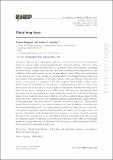Chiral drag force
Author(s)
Rajagopal, Krishna; Sadofyev, Andrey
Download13130_2015_Article_2239.pdf (720.6Kb)
PUBLISHER_CC
Publisher with Creative Commons License
Creative Commons Attribution
Terms of use
Metadata
Show full item recordAbstract
We provide a holographic evaluation of novel contributions to the drag force acting on a heavy quark moving through strongly interacting plasma. The new contributions are chiral in the sense that they act in opposite directions in plasmas containing an excess of left- or right-handed quarks. The new contributions are proportional to the coefficient of the axial anomaly, and in this sense also are chiral. These new contributions to the drag force act either parallel to or antiparallel to an external magnetic field or to the vorticity of the fluid plasma. In all these respects, these contributions to the drag force felt by a heavy quark are analogous to the chiral magnetic effect (CME) on light quarks. However, the new contribution to the drag force is independent of the electric charge of the heavy quark and is the same for heavy quarks and antiquarks, meaning that these novel effects do not in fact contribute to the CME current. We show that although the chiral drag force can be non-vanishing for heavy quarks that are at rest in the local fluid rest frame, it does vanish for heavy quarks that are at rest in a suitably chosen frame. In this frame, the heavy quark at rest sees counterpropagating momentum and charge currents, both proportional to the axial anomaly coefficient, but feels no drag force. This provides strong concrete evidence for the absence of dissipation in chiral transport, something that has been predicted previously via consideration of symmetries. Along the way to our principal results, we provide a general calculation of the corrections to the drag force due to the presence of gradients in the flowing fluid in the presence of a nonzero chemical potential. We close with a consequence of our result that is at least in principle observable in heavy ion collisions, namely an anticorrelation between the direction of the CME current for light quarks in a given event and the direction of the kick given to the momentum of all the heavy quarks and antiquarks in that event.
Date issued
2015-10Department
Massachusetts Institute of Technology. Center for Theoretical Physics; Massachusetts Institute of Technology. Department of PhysicsJournal
Journal of High Energy Physics
Publisher
Springer Berlin Heidelberg
Citation
Rajagopal, Krishna, and Andrey V. Sadofyev. “Chiral Drag Force.” Journal of High Energy Physics 2015.10 (2015): n. pag.
Version: Final published version
ISSN
1029-8479